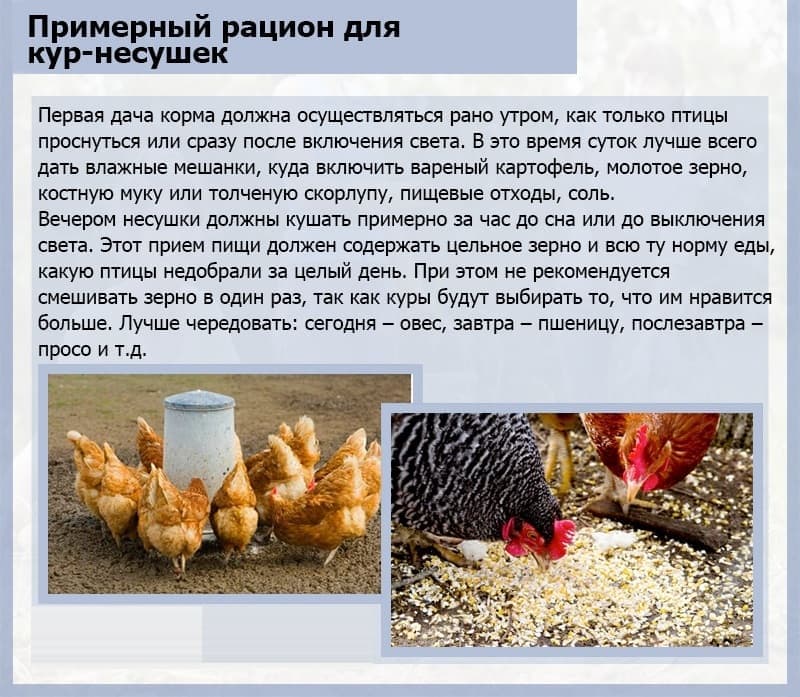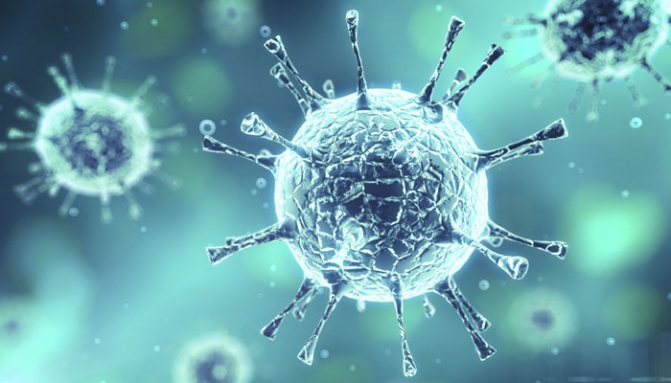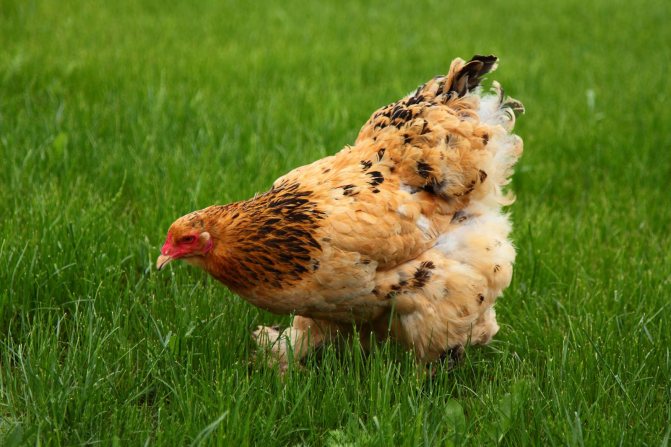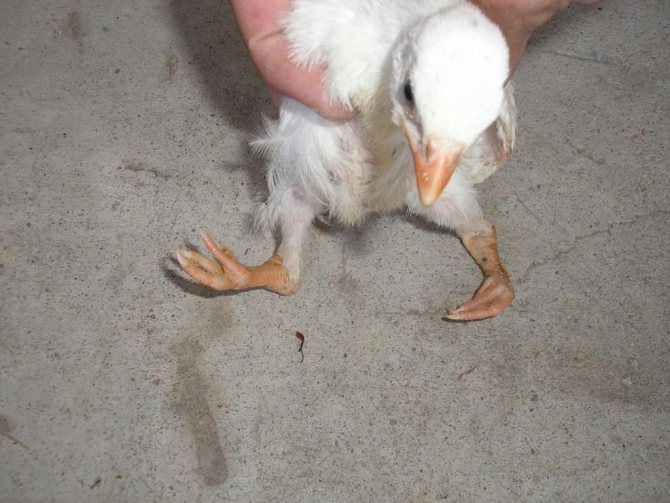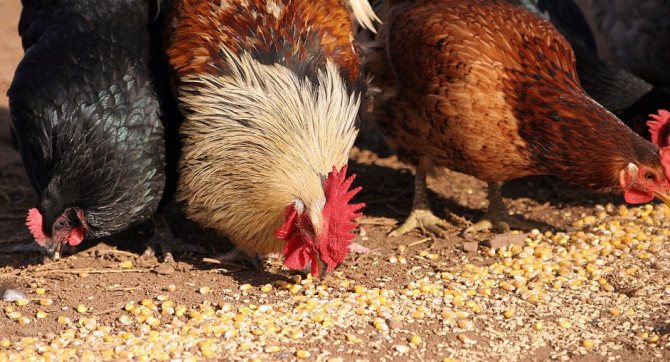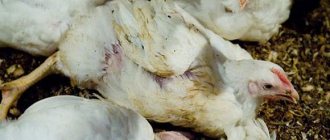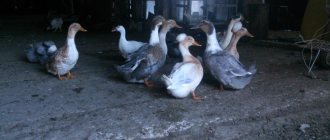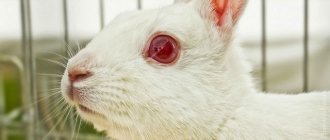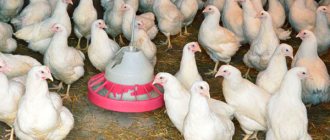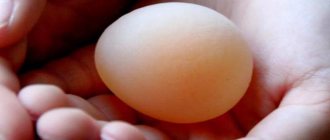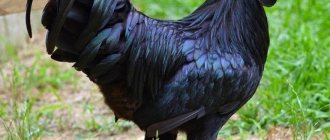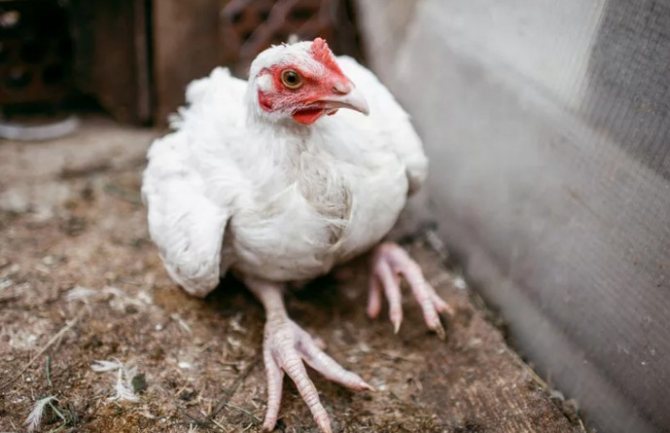
At first glance, poultry farming is considered a difficult business, it brings benefits, and even income, by supplying owners with tasty and nutritious foods. But breeders can expect rejection of the moments, it happens that the chicken falls to its feet, there can be many prerequisites for this, poultry farmers need to understand chicken diseases, identify pathologies in time, and, if possible, treat them.
The reasons
Factors that negatively affect the musculoskeletal system of chickens are different. The legs of a bird can fail for etiological reasons, for example, if they are kept in a tight space, they can make many movements, respectively, even in healthy individuals, the support system collapses, deformities of the joints, ligaments appear, the legs become overgrown with growths.
Tip: If you feed chickens at random, lack vitamin and mineral food, or overfeed, the bird may also develop limb problems.
Problems with bird legs can be blamed on gout, lesions when chickens have bent fingers, joint diseases such as: arthritis, arthrosis, tendovaginitis, etc. Diseases of the limbs can also begin from knemidocoptosis.
Poultry limp with various injuries of the paws, stretch marks and damage to the ligaments, dislocations and bruises, if the nerve trunks or muscles are damaged.
Joint disease can be the result of mechanical damage, infections, improper care of chickens. If chickens and chickens are little in the sun, the bird's body produces vitamin "D", and if you do not drink or feed supplements with this vitamin in the composition, the chickens will fall from rickets. To cure chickens, you will need to give them 10 to 50 drops of fish oil or synthetic preparation "Vitamin D"
In poultry, calcium and phosphorus metabolic processes are disturbed, as a result, bone tissue is poorly formed in young animals, in adult chickens, bones can become thinner, become more fragile, and collapse. As a result, the legs become chronically weakened, and the eggshells of sick chickens become deformed.
A chicken is sick with rickets, if, in addition to falling on its paws, it has shaggy, disheveled feathers, poor appetite, unwillingness to move and impaired coordination. Sick chickens become much worse if, within a period of 3 weeks, the owner has not ascertained the appearance of an illness. The final stage will be a complete breakdown, the failure of all organs of chickens, they die.
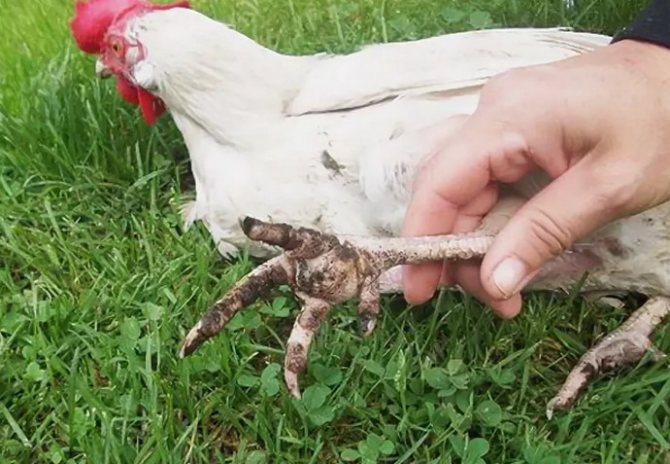

Advice: When chickens have calcium deficiency, this can be seen by their beak, when you feel its unnatural softness. If the laying hen began to produce egg products, the shell of which is fragile and soft, it is urgently necessary to replenish its body with vitamin "D".
With an imbalance in the chicken diet, the death of individuals is sometimes observed. The problem with the legs will occur if the bird is given one compound feed. To balance the diet, in addition to grain, chickens must feed on herbs, raw and boiled root vegetables (beets, carrots and cabbage, pumpkin, etc.).
Five-day-old chicks can receive the necessary elements for development and growth, which are in special veterinary preparations, they are sold in a liquid state, so they are given, funny with water or food. You cannot keep a bird for a long time without chalk, shell, salt additives and bone meal.
Advice: Trace elements should not be given in excess, the dosage is calculated according to the instructions, farmers take into account the weight and age of the chickens.
If the chickens move little and live in tight spaces, this affects their productivity and health. The same effect on chickens is exerted by dirt in the barn, constantly wet bedding, clogged with droppings and poultry urine. In unsanitary conditions, a pathogenic fungus spreads quickly. Infected chickens can barely walk with enlarged joints and high temperature of the injured organ.
If the room is too sterile, it is also a way to keep the livestock healthy. After careful processing, beneficial bacteria become less or they are completely destroyed. With a disturbed microflora of the living environment of chickens, their immune system is weakened. There is a loss of appetite in the bird, and its legs are also taken away from it, if no measures are taken in time. Normally, there should be indicators of humidity, temperature in a room with chickens, an inflow and circulation of fresh air should be provided.
Video
This video will tell you about the reasons why chickens fall on their feet, as well as how to treat this disease.
It can be difficult to independently recognize the reason why a bird falls on its paws or they completely refuse it. Some poultry farmers prefer to slaughter a weakened individual, rather than treat it. In certain cases, such a decision helps to avoid an epidemic, but it is not always justified. After all, it makes sense to first show the sick chicken to the veterinarian, and only after that decide its further fate. You can find the characteristics of the Leghorn breed at the link provided.
Sit on their feet
It happens that a chicken can sit on its feet, the reasons must be identified quickly, since a serious illness or injury, for example, a fracture, can contribute to the fall. If a chicken has injured or injured a leg, before drawing conclusions and starting treatment, you should do a close examination of the limbs, feel all the joints, and detect swelling and redness of the damaged areas. A wound on a chicken's finger cannot always be seen with a cursory glance; special attention to detail is required.
Arthritis
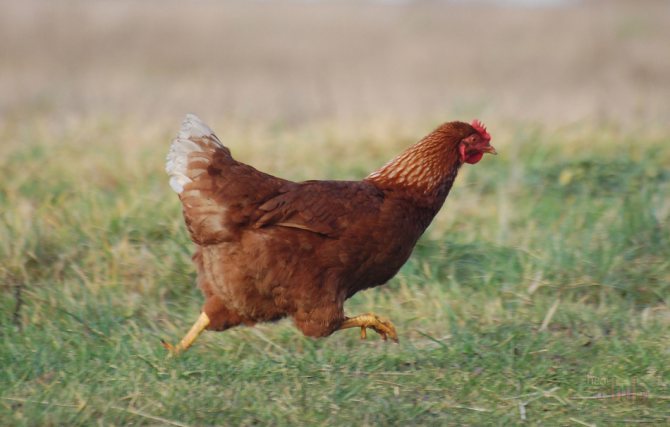

In the people this disease of poultry is also called "the disease of dirty feet." This joint disease is of viral origin. In more rare cases, arthritis occurs as a result of an unbalanced, poor diet.
Often, viral arthritis is called tenosynovitis. The causative agent of a dangerous disease is reovirus. In this case, the chicken will first start to limp, then it will become practically motionless. A rupture of the shin bones, severe destruction of the cartilaginous tissue on the legs are likely.
The bird's appetite decreases, and the color of the skin becomes pale. Egg production and weight of the bird are also noticeably reduced. Often, viral arthritis develops as a complication after infectious diseases suffered by poultry.
It is not difficult to detect the disease: you just need to carefully feel the joints of the bird. With arthritis, the joints will be noticeably sore, swollen, and hot to the touch.
Additional symptoms may include the following:
- pain in the legs of the bird;
- stiffness of movements, leading, among other things, to falls;
- a complete failure of the legs is also possible - then the birds sit or lie down and practically do not move.
Note that this disease is dangerous and is difficult to tolerate chicken. If the disease is not treated, the inflammation will spread from one joint to others, expand, and go deeper into the tissues.
Thus, the acute phase of the disease flows into the chronic one. More often adults suffer from arthritis, chickens are much less common.
What to do?
Arthritis needs to be treated urgently, as the disease progresses rapidly. Special antiviral drugs are prescribed.
Along with antivirals, antibiotic treatment is also indicated.The following drugs can be considered as suitable antibiotics for viral arthritis:
- Ampicillin;
- Sulfadimethoxine;
- Polymyxin M sulfate;
- Benzidpenicillin.
Give antibiotics to chickens for at least five days. Usually the course takes a week, but if arthritis progresses strongly, then longer. It is undesirable to self-medicate, it is recommended to show sick birds to a veterinarian.
They also treat folk remedies, which are quite effective according to reviews. So, some poultry farmers give a sick chicken vodka to drink: however, with this method it is important not to overdo it with the "treatment". Otherwise, the bird will be done more harm than good.
Preventive measures are also important to help minimize the likelihood of illness. To prevent chickens from getting arthritis, keep the room where they are kept clean. It is necessary to carry out regular cleaning of cages and pens, and immediately isolate diseased birds from the rest.
Multivitamins and green foods will be very useful for arthritis.
Fall to their feet
If the chicken limps on one or two limbs, its joints are enlarged and swollen, the legs are damaged, the bird can fall when it walks, or lie down without rising from one place.
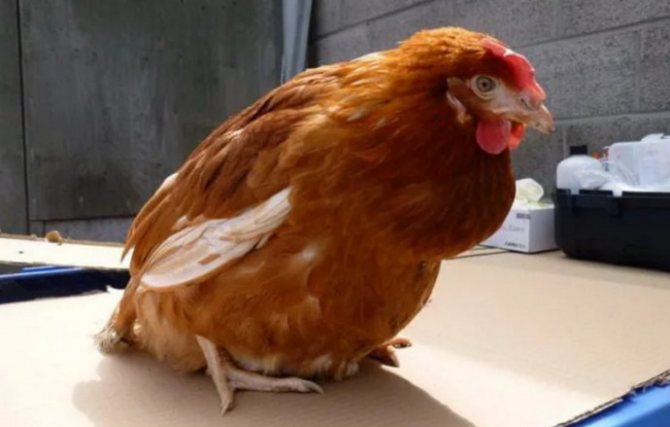

As a preventive measure, it is recommended to regularly clean the chicken coop and inventory items. Where chickens walk freely, it is also necessary to ensure cleanliness.
Isolation of sick hens from the herd will be the therapeutic measure. The wounds of the legs of the bird will need to be treated with brilliant green or iodine. When arthritis or tendovaginitis becomes the culprit of a bird falling to its feet, individuals are drunk with antibiotic drugs (Sulfadimethoxin, Ampicillin or Penicillin), and agents against viral infections for 5 days, injections can be made, can be mixed with food.
Arthritis is also treated with multivitamin chicken feed supplements, tricalcium phosphate and herbs on the daily menu. Frequent walks should take place, if the season is warm, in the winter months, chickens should be released in favorable sunny weather or in a thaw, when there is light frost, limiting only the time spent outside. It is imperative to extend daylight hours with the help of lighting devices in the chicken coop.
Viral arthritis and staphylococci can only be cured by vaccination. The bird is relieved of pododermatitis by revising its feeding, cleaning the nests and perches of chickens. The litter should laugh often. Chicken legs can be smeared with fish oil or synthamycin ointment.
Perosis is difficult to treat, death among young animals is not uncommon. Adult chickens can survive if they are fed with supplements with a lot of vitamin B, P, magic, manganese and iodine must also be present in the feed.
In summer
In the summer, when the bird mostly walks all day in the wild, the chicken may step on a piece of glass or nails in the yard, the resulting wound hurts and can fester, it is easier for the chickens to stand or sink down. If a reckless hen jumps off an excessively high perch, she can get stretched, or dislocate, break her leg.
Tip: For heavy chickens, it is not recommended to install the perch at a high height, the maximum permissible distance of the handrail from the floorboards is 90 centimeters.
In winter
The cold season is dangerous for almost all breeds of chickens, especially if they are not frost-resistant. Long winter walks, or short, but in severe frost, harm the health of the chicken herd, which can easily catch colds or frostbitten feet when walking in the snow.
Insulated chicken coops with lighting and optimal air temperature are suitable for winter keeping chickens. Dry litter on the floor is of no small importance; feet can also freeze when walking on a cold surface.
Treatment of diseases
As soon as the first signs were noticed, you need to immediately start treating the bird:
- in case of disorders in the joints, the diet is replenished with tricalcium phosphate;
- in case of inflammatory processes in the tendons, the feed is enriched with vitamin B and manganese;
- with arthritis and tendovaginitis, birds are fed multivitamin supplements, antiviral and antibacterial drugs are used for a week, and paws are also lubricated with syntamycin ointment or fish oil;
- Knemidocoptosis is treated with acaricidal agents: the solution is heated, poured into a basin and the paws of a sick chicken are immersed;
- with perosis, adult chickens are given vitamins B4, B12 and B7;
- in case of injuries and lameness, the bird is set aside, the wound is treated.
It is recommended that a weak and sick chicken be removed from its relatives immediately, since the stronger ones can peck it.
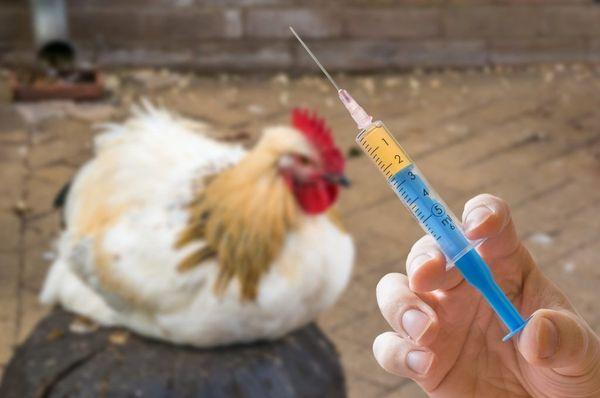

Doesn't get up
The chicken may not get up if it has undergone Marek's disease. The nervous system and visual organs of the individual who have picked up the virus are affected. The chicken's bones, organs and skin swell. The motor function is impaired, the bird cannot stand up. Her pupils become narrower, changes also touch the iris of the eye.
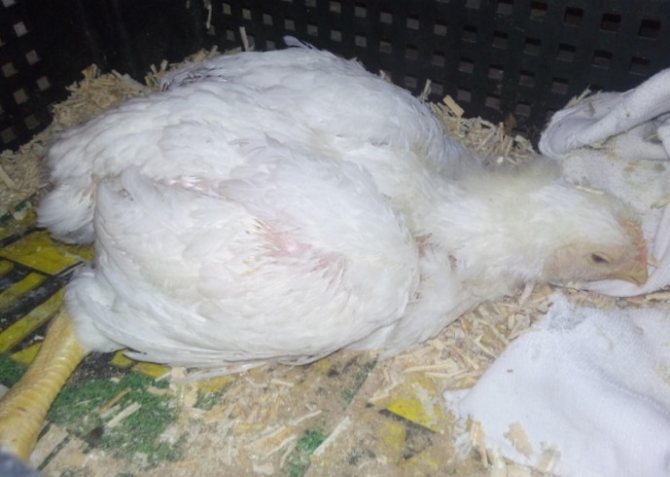

A sick individual refuses to feed, and is depleted in a short time. The crest and earrings become faded. The last stage is characterized by loss of vision of the bird, sick individuals breathe heavily, stand with lowered wings, if the chicken falls to its feet, then more often on its side. At this stage, remedial measures are powerless, but the infection is dangerous and spreads quickly. Therefore, urgent prevention of all poultry and isolation of the sick is mandatory. As a rule, Marek's disease is not treated, infected individuals are destroyed, young animals in the herd are urgently vaccinated.
Perosis is hereditary, and is determined by the dominant gene that the parent hens have. Adult birds do not get sick, their offspring suffer from an ailment, it appears if the birds lack vitamins of group B. If there is not enough thiamine (B 1), paralysis of the legs and neck may occur, the chicken is pulled back, it collapses. For treatment, 100 mcg is given. the drug in 4 days.
With vitamin E deficiency, the chicken walks as if swaying, with the defeat of the legs, the fingers twist. Synthetic tocopherol is poured into the cereal.
general information
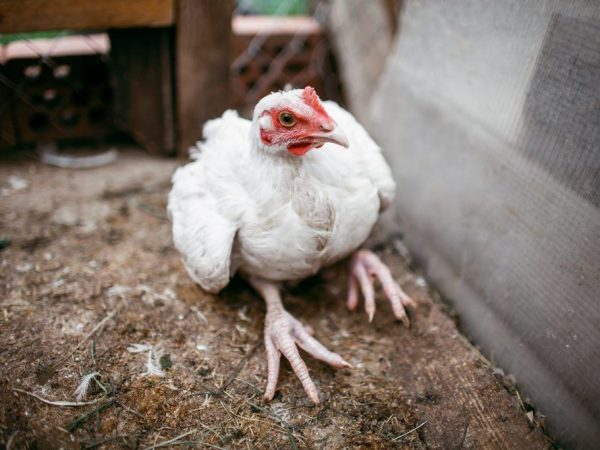

Of course, those farmers who have been engaged in poultry farming for several years are already familiar with this problem and imagine how to treat chickens, do not panic. But a novice farmer has a hard time: you can literally fall into a stupor, especially if the pathology "suddenly" affects several individuals at once.
Note that whatever the reason, the damage to the farm will in any case be done: and the more birds are affected, the more noticeable the damage.
In chickens, egg production decreases, and those eggs that appear, often fragile, have a thin shell. In addition, the costs of treatment can be substantial and the number of poultry is sometimes drastically reduced.
Chickens can fall to their feet, limp for various reasons, the most common of them are as follows:
- critical lack of vitamins and minerals in the poultry menu;
- inflammation of the tendons, arthritis, rickets;
- other diseases;
- trauma, wounds and cuts;
- keeping poultry in the wrong conditions.
Next, we will go through all the points in detail and learn how to identify each of the causes and how to treat birds.
Why do chickens start to limp
Chickens usually begin to limp as a result of leg diseases and injuries. Lameness not only causes gait disturbance, but often causes the hen to stop walking altogether.
Errors in maintenance, feeding, birth defects can provoke a violation. Some of the pathologies are infectious.
Regular chicken keepers usually only experience paw problems if the pets are injured.


Chickens usually start limping as a result of leg diseases and injuries.
Paw injuries are common. Usually there is a bruise, a violation of the skin.Dislocations and fractures are less common.
Especially often, damage to the paws occurs in chickens of the meat direction, which are equipped with high perches in the hen house. Jumping down, heavy birds easily injure fingers or the shin bone.
For chickens over 3 kg, boxes are recommended for sleeping, not perches.
Vitamin deficiency
Diseases in which chickens are severely lame or practically cannot move are associated with bone damage. One of the possible reasons in this case is the lack of vitamin D in the bird's body.
Possible causes of vitamin deficiency:
- inadequate feed, which lacks calcium and phosphorus;
- poor lighting in the chicken coop;
- lack of sun (ultraviolet radiation);
- content in cramped quarters without walking.
Symptoms:
Rickets (hypovitaminosis D)
Chickens and reared chickens are more likely to suffer from this disease, but it is possible that the disease can spread to the adult population of chickens.
With rickets, the following symptoms are pronounced: decreased appetite, curvature of the keel, dull and dirty feather sticking out in different directions, diarrhea, softening of the beak and claws, lameness of chickens, decreased motor activity of young animals, impaired coordination of movement, decreased egg production, thinning and fragility of the eggshell.
Untimely treatment of rickets leads to the death of chickens and adult birds.
Treatment of hypovitaminosis D is carried out using vitamin D3, vitamin D2 concentrate, tricalcium phosphate and fish oil.
Gout
Chicken can also be affected by this "disease of kings." Gout is caused by the accumulation of salts and uric acid in the joints. The symptoms of the disease are swollen and very dense joints. On the legs of the bird, you can see characteristic growths-bumps.
Birds tolerate gout hard: they walk little and poorly, sometimes they literally fall off their feet. Because the movement is painful, the chicken cannot be moved.
Usually, the cause of the pathology is prolonged feeding with compound feeds with a high content of meat and bone or fish meal. As a result of such nutrition, the metabolism in the bird's body is disrupted.
What to do?
It is necessary to balance the diet, remove excess compound feed with flour provoking gout. It is advisable to transfer layers to a diet with a predominance of whole and sprouted grains.
How can I help a chicken?
First of all, the victim must be removed from the common herd so that she has the opportunity to eat and drink plenty of water. But first, you should watch the bird - often lame chickens behave even more energetically than absolutely healthy ones, and in this case they should not be removed.
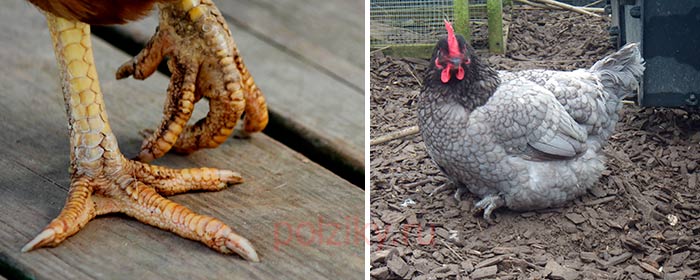

The next step is to examine the problem foot:
- if a splinter is found, then it must be taken out with tweezers and the wound should be treated with any antiseptic (banal "brilliant green" is also suitable);
- in the event of a leg fracture, you will have to spend a lot of time on the restoration of the bird - they put a splint on it, monitor their behavior and be sure to separate it from the general herd;
- in case of frostbite, they act as follows: they bring the chicken into the heat (many donate their own "apartments"), provide it with a fortified drink (you can add multivitamins to the water at the rate of 1 ml per liter) and keep it until the color and shape of the paws are restored.
If a the chicken is limping in one leg in winter, but the color of its paws has not changed, then in order to avoid problems, the bird should be brought to a warm place - most likely, lameness will be the first sign of frostbite.
If the bird is in a warm enclosed space, then lameness can also mean a lack of vitamins / trace elements - it is worth drinking the whole flock with calcium and iron - there are special complex preparations in the vetaptek.
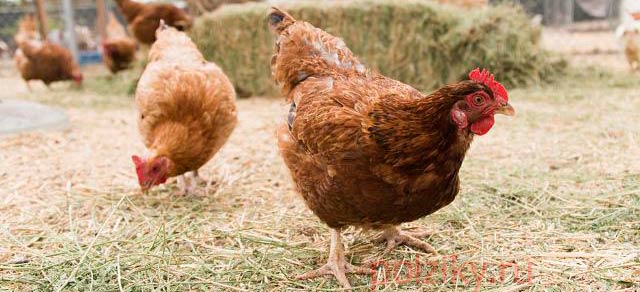

Why chickens start to limp - types of diseases
In order not to be mistaken in the diagnosis of chicken lameness, it is worth observing it closely for several days.
It is believed that if a bird behaves energetically, does not refuse food, continues to lay eggs and has not changed outwardly, then it is worth leaving it alone - often such "cripples" live long enough and lay eggs, and even delight the offspring. But if the chicken began to limp against the background of lethargy, lack of eggs (or they are deformed / small in size), poor appetite, then it is worth considering that this may be a symptom of a dangerous disease.
You should call a veterinarian who will conduct certain examinations and diagnose. By the way, if the listed infectious diseases are still diagnosed, then it is impossible to eat the meat of such a layer.
Please note that any infectious disease will affect the entire flock, so a single lame chicken is not an indicator of a problem. If you wish, you can hack it down.
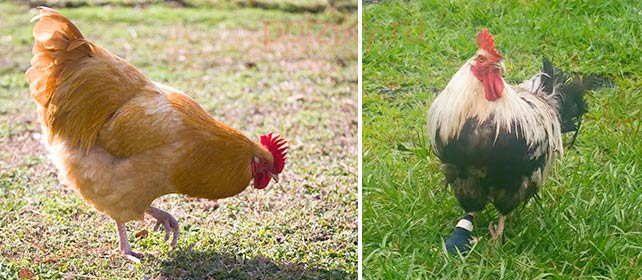

Often, lameness is associated with pathologies of the development of fingers - for example, they can be turned to the side, which indicates the improper maintenance of the bird - the litter is wet / cold, lack of vitamins.
Such a bird will be difficult to restore, so an ax is the best tool in this case. If the chicken is active and carries well with twisted fingers, then leave it alone, let it live and please with eggs.
Chicken lameness is not always an indicator of a problem in the herd. An attentive owner will definitely pay attention to the general behavior of his wards and how many individuals are prone to lameness. If this is an isolated case, then don't worry. But with mass lameness, it is worth calling a veterinarian - some infectious diseases require monitoring by specialists.
Reovirus infection (tenosynovitis, viral arthritis, pale bird syndrome and food indigestion)
Not only adult chickens, but also chickens from a bird carrying the virus can become infected with a reovirus infection.
Symptoms of the disease: Incorrect positioning of legs in chickens, lameness of a bird, diarrhea, refusal to eat, weight loss, depression, edema with bruising of the tendon sheath, ruptures of atrophied tendons, decreased egg production, decreased hatchability of chicks.
Expert opinion
Sadchikov Nikolay Alekseevich
Ornithologist veterinarian
Ask a Question
In young chickens affected by reovirus infection, the mortality rate is 5-18%, in adult poultry - 1.5-3%.
For the treatment of the disease, sulfadimezin and antibiotics are used: paracillin sp, enroxil, baytril, gentamicin.
Symptoms
Let's talk about signs that can be signals that a bird has problems with its paws:
- Lameness appears by chance. Sometimes it grows smoothly. Can affect one or both limbs.
- Swelling of the joints, an increase in their size. One gets the impression that they are a little turned inside out.
- Paws tremble, resulting in lameness.
- After a short run, the legs begin to break.
- The bird stands on its paws for a long time, cannot stand for a long time.
Broilers
Meat breeds of birds are distinguished by an increased appetite, therefore they grow very quickly. If the chick falls on its paws, it is difficult for it to regain motor functions. Treatment should be carried out immediately and not wait for the manifestation of other symptoms.
Broiler chickens most often suffer from violations of the technology of keeping. Unlike egg breeds, they react painfully to a lack of vitamins A, D, E and calcium deficiency. Often the livestock is grown in closed pens, so the birds do not have enough ultraviolet radiation.
The crowded content of chickens also negatively affects the immunity of the young. Chicks react painfully to excess moisture and low temperatures in the chicken coop. In addition to all of the above, excess weight becomes the cause of the problem.
Conditions for keeping birds
For successful breeding of birds, certain conditions must be created.Among the most significant are the following:
- well equipped, warm and clean poultry house;
- walking area;
- balanced diet;
- compliance with sanitary standards of maintenance;
- good lighting of the room.
Of no small importance is also how correctly the breed of chickens is chosen. The conditions in which it will be located depend on this.
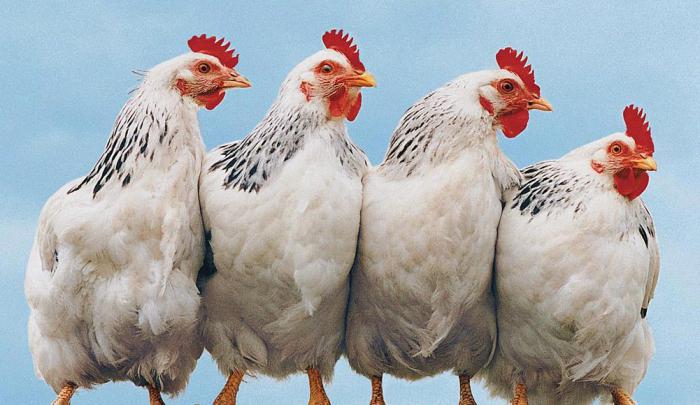

Chickens
A variety of materials can be used to build a poultry house, but it is better if they are natural. The room should be spacious, light, well-ventilated and warm. For good lighting, the chicken coop should have not only windows built into the walls, but also artificial lighting. For this purpose, fluorescent lamps can be used.
Good ventilation can be ensured by means of equipment in the ceiling of a box with doors that can be easily opened if necessary. In addition, the room must be ventilated by opening the doors in it.
Planks or clay can be used to equip the floor.
Advice! It is better to build the floor with a slight slope. This will greatly facilitate the cleaning process.
It is recommended to cover the floor surface with straw, hay or sawdust. The room must be equipped with perches. They should be narrow so that the birds can easily wrap their legs around them. The height of the perch can vary within 0.5 - 0.8 cm. To save space in the hen house, perches can be arranged in several tiers.
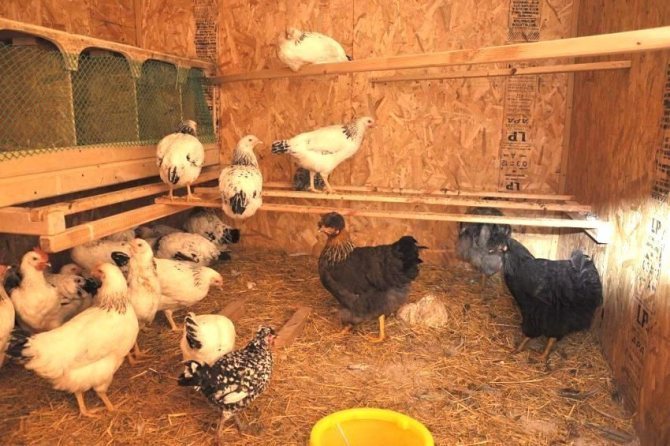

Arrangement of a chicken coop
An equally important condition for equipping a hen house is the construction of nests for laying hens. To do this, you can use wooden boxes, the inside of which is covered with straw or hay. Their number depends on the size of the herd.
If it is planned to keep chickens of different ages in the hen house, it is better to divide its territory into separate zones by using boards with a height of at least 0.5 m. It is also desirable to have an open-air cage for walking chickens. The territory of the aviary is fenced off with a net or a wooden fence. The height of the fence should be within 1, 5 - 2, 0 m. The area is recommended to be sown with green manure.
Chicken lameness
Lameness in chickens can be a symptom of a serious illness, but it can also be considered as a separate pathology caused by the following reasons:
- mechanical injuries - cuts, bruises, joint dislocations, sprains, etc.;
- damage to the nerves that innervate the limbs.
This defect can manifest itself both immediately in full and gradually. At the same time, the chicken behaves restlessly, since it limps and it is difficult for it to move. In addition, she often flaps her wings and sits down to rest even after short walks.
Tendon displacement
Sometimes the chicken walks with a limp because it suffers from a dislocation of the tendons. This disease is more common in broilers, so try to inspect your broilers more often. In general, fast-growing poultry are often affected by tendon misalignment. In addition, if during the period of active development, the chicken does not receive vitamin B or it is given an unbalanced feed, do not be surprised that you are faced with such a deviation.
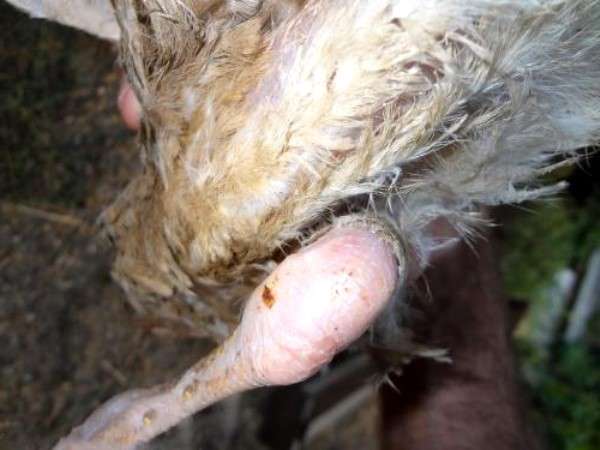

It is quite simple to define such a disease: the tendons swell to a large size, and then seem to be twisted. The first thing to do in this case is to actively add vitamin B or manganese to food. But if the situation has worsened noticeably, and poultry refuses food and water, the only way out is to slaughter sick individuals.
Disease prevention
Preventive measures are reduced to the following points:
- Balanced nutrition and the addition of vitamin and mineral supplements (tricalcium phosphate).
- Sanitary treatment of the chicken coop and aviary, their compliance with sanitary and hygienic standards.
- Vaccination of young animals.
- Livestock care, ensuring microclimatic conditions in the chicken coop.
- Providing daily walking for chickens.
- Do not thicken the livestock, provide sufficient space for the birds.
- Release new individuals into the general herd only after quarantine measures.
The fall of chickens on their feet is possible with numerous diseases. Preventive measures and monitoring the number of chickens, as well as timely examination by a veterinarian and treatment, in most cases, prevents the death of birds, and therefore the loss of the breeder.
0
Crooked fingers
Chickens can get this disease of the feet in the first month of life. With crooked toes, the chicken walks, waddling, leaning on the outer sides of the foot. Chickens with such a defect are not left for the tribe, since there is always the possibility that this is a genetic deformity.


Causes of the disease:
- concrete floor of the chicken coop without dry and warm bedding;
- mechanical trauma to the feet;
- keeping young stock in boxes with a mesh floor;
- non-observance of incubation conditions;
- bad heredity.
Symptoms: a peculiar gait, a chicken with crooked toes rests on the lateral surfaces of the legs when walking.
Treatment: ethen the disease is not cured.
Prevention:
- For young poultry from the first days of life, you need to create comfortable conditions (warm and even floor, dry litter).
- Eggs for incubation should not be taken from chickens with crooked toe disease.
- When incubating eggs, you must strictly adhere to the incubation regime.
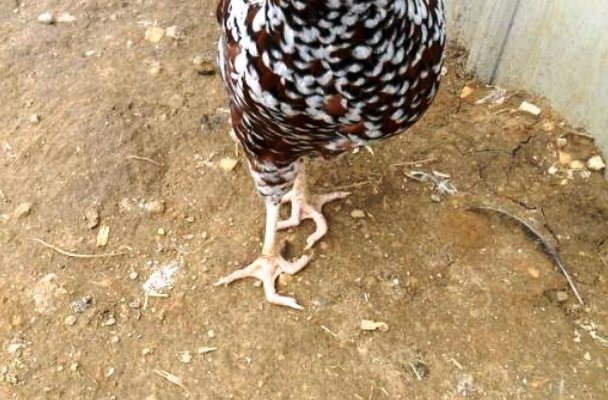

Did you know? Chickens love to bathe in dust. Dust baths, in addition to the pleasure they bring, help the birds to fight the insects living in the feather cover.





